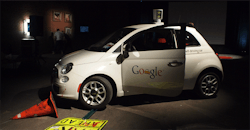Regulator Says Self-Driving Cars Must Be Twice as Safe
"I'd actually like to throw the gauntlet down," Mark Rosekind, head of the National Highway Traffic Safety Administration, said Wednesday at a conference in Novi, Michigan. "We need to start with two times better. We need to set a higher bar if we expect safety to actually be a benefit here." Rosekind wouldn't disclose specifics of the autonomous-auto regulations he said U.S. Transportation Secretary Anthony Foxx will announce in July. The NHTSA chief said those rules will speed the deployment of self-driving cars, which should begin to reduce road deaths that jumped last year to 38,300 from 32,675 in 2014.
"It's a 747 crashing every week for a year, that's what the losses are on our highways," Rosekind said at the TU-Automotive Conference. "And that is unacceptable."
Several thousand driverless cars will be sold in the U.S. in 2020 and grow to almost 4.5 million sold during 2035, researcher IHS Automotive said in a forecast released Tuesday.
Globally, 21 million of the vehicles are expected to be sold in 2035, more than double IHS's prediction two years ago. IHS cited accelerated activity and deal-making in driverless cars, such as General Motors Co.'s investment in ride-hailing company Lyft Inc. and Fiat Chrysler Automobiles NV's alliance with Google to create about 100 self-driving minivans.
"Global sales of autonomous vehicles will reach nearly 600,000 units in 2025," Egil Juliussen, research director at IHS Automotive, said in a statement. "Our new forecast reflects a 43% compound annual growth rate between 2025 and 2035 -- a decade of substantial growth, as driverless and self-driving cars alike are more widely adopted in all key global automotive markets."
Potential Lifesaver
Safety regulators welcome automated driving as a lifesaver because NHTSA estimates that 94% of all road deaths are the result of human error. The challenge is to overhaul 1960s-era safety regulations that never contemplated removing the human from behind the wheel. The U.S. agency earlier this year ruled that Google's self-driving software is the equivalent of a human driver. In January, Foxx said NHTSA planned to issue guidelines on safe deployment of autonomous vehicles within six months. They would include how self-driving cars should be tested and the benchmarks that must be achieved to allow them on public roads.
Rosekind said Wednesday that the rules to be announced next month will provide "deployment and operational guidance for how to get all of these autonomous new safety technologies on the road safely."
State Model
NHTSA also will provide a "model state policy" for local regulations of autonomous vehicles to "help support a uniform, consistent framework" of rules for manufacturers and travelers, he said. In addition, the agency will identify "new tools and authorities to really help advance if not accelerate getting these new technologies on the road safely."
President Barack Obama's proposed 2017 budget calls for spending $3.9 billion on autonomous-vehicle technology over the next 10 years. Congress has not yet acted on his request.
"We are witnessing a revolution in auto technology that has the potential to save thousands of lives," Foxx said in March. "In order to achieve that potential, we need to establish guidelines for manufacturers that clearly outline how we expect automated vehicles to function -- not only safely, but more safely -- on our roads."
